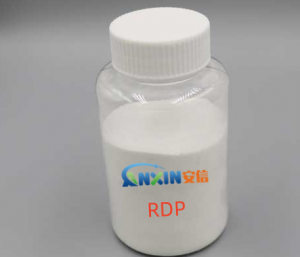Redispersible Polymer Powder (RDP), as an important polymer additive, has been widely used in recent years in dry-mix mortar, tile adhesive, putty powder, plastering mortar, and grout. Its application in tile grout is particularly valuable in improving bond strength, flexibility, crack resistance, and water resistance.
1. Mechanism of Action of RDP
RDP is a redispersible powder made from a polymer emulsion through a spray drying process, possessing the characteristic of re-emulsification upon contact with water. When RDP is added to the grout, as water evaporates during construction, the RDP particles redisperse to form a continuous polymer film. This polymer film interweaves with cement hydration products, forming an “inorganic-organic composite system,” significantly improving the material’s mechanical properties and interfacial bonding characteristics.
During the curing process of the grout, the RDP polymer film can coat filler particles, improving interfacial adhesion and reducing the porosity of the cement-based system. Furthermore, the flexible segments in RDP molecules give the grout a certain degree of ductility and resistance to deformation, effectively preventing cracks caused by temperature changes or substrate deformation.
2. RDP Enhancement of Tile Grout Performance
2.1. Improved Bond Strength
The primary requirement for tile grout is good adhesion to the tile edges and substrate. RDP forms an organic polymer film, making the interface between the cement-based grout and the tile surface more firmly bonded. Simultaneously, the polymer residue after the hydration reaction of RDP enhances the density of the interface layer, thus significantly improving the grout’s bond strength and durability.
2.2. Enhanced Flexibility and Crack Resistance
Traditional cement-based grouts are prone to micro-cracks when drying shrinkage or temperature changes, affecting aesthetics and waterproofing performance. The introduction of polymer components in RDP improves the material’s flexibility and ductility, allowing the grout layer to withstand certain stress and deformation without cracking, thereby extending its service life.
2.3. Improved Waterproofing and Impermeability
The continuous polymer film formed by RDP has a low permeability coefficient, effectively preventing water penetration and reducing water absorption. This property is especially important in damp environments such as kitchens and bathrooms, effectively preventing moisture from seeping into the back of tiles or the substrate along the gaps, reducing the risk of mold and hollowing.
2.4. Enhanced Abrasion Resistance and Stain Resistance
High-quality RDP improves the surface density of the grout, making it smoother, more abrasion-resistant, and reducing dirt adhesion. RDP-modified grout is less prone to dust accumulation or discoloration during daily cleaning, maintaining its aesthetic appeal for longer.
2.5. Improved Application Performance
RDP significantly improves the application flow and water retention of the grout, making application smoother, easier to fill gaps, and reducing voids and air bubbles. Simultaneously, its water-retaining effect slows down the hydration rate of cement, giving workers more time for application and improving application quality and efficiency.
3. RDP Application Performance in Different Types of Grout
3.1. Cement-Based Grout
Adding RDP to ordinary cement-based grout significantly improves adhesion and crack resistance, making it particularly suitable for grouting indoor and outdoor wall and floor tiles.
3.2. Epoxy or High-Performance Grout
For high-end grout formulations requiring high wear resistance and impermeability, RDP, as a modifier, works in conjunction with other resins to further enhance flexibility and adhesion.
3.3. Colored Grout
RDP film-forming properties help ensure uniform pigment distribution, enhance color durability, prevent color differences and efflorescence, and make colored grouts more decorative.
4. Application Value and Development Trends of RDP
In summary, the application value of RDP in tile grout is mainly reflected in the following aspects:
Improved Product Performance Stability: By improving adhesion, waterproofing, and flexibility, grout maintains excellent performance in different environments.
Extended Service Life: Enhanced crack resistance and wear resistance, reducing later maintenance costs.
Enhancing the construction experience and finished product quality: Improves workability and water retention, reducing construction defects.
Aligning with the development direction of green building materials: RDP is a solvent-free, low-VOC material, meeting environmental protection requirements and contributing to the construction of green building systems.
As the building decoration industry develops towards high performance, environmental protection, and aesthetics, the role of RDP in tile grout will become increasingly important. Future research and development will focus on developing polymer systems with higher weather resistance, lower water absorption, and stronger adhesion to meet application needs under different climates and construction conditions.
As a core modifying material in tile grout, RDP can significantly improve its mechanical properties, crack resistance, waterproofing, and workability, making it a key additive for achieving high-quality building decoration effects. Its widespread application not only optimizes the overall performance of grout but also provides solid support for the development of green and energy-saving building materials.
Post time: Nov-05-2025
